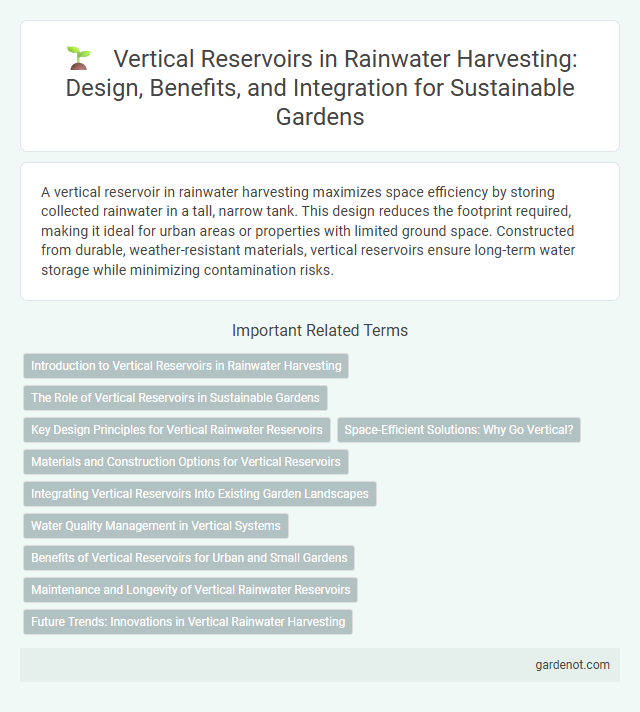A vertical reservoir in rainwater harvesting maximizes space efficiency by storing collected rainwater in a tall, narrow tank. This design reduces the footprint required, making it ideal for urban areas or properties with limited ground space. Constructed from durable, weather-resistant materials, vertical reservoirs ensure long-term water storage while minimizing contamination risks.
Introduction to Vertical Reservoirs in Rainwater Harvesting
Vertical reservoirs in rainwater harvesting are designed to store collected runoff efficiently in limited spaces, utilizing height rather than surface area. Commonly constructed from materials like reinforced concrete, plastic, or steel, these reservoirs minimize land use while maximizing storage capacity. Integrating vertical reservoirs with filtration systems ensures a sustainable water supply for domestic and agricultural applications.
The Role of Vertical Reservoirs in Sustainable Gardens
Vertical reservoirs maximize rainwater storage capacity in compact garden spaces, promoting efficient water use and reducing dependency on municipal supply. Their design allows for gravity-fed irrigation systems, minimizing energy consumption while sustaining plant health. Integrating vertical reservoirs supports sustainable gardening by enhancing water conservation and enabling resilience during dry periods.
Key Design Principles for Vertical Rainwater Reservoirs
Vertical rainwater reservoirs must prioritize structural stability by using reinforced materials such as concrete or steel to withstand hydrostatic pressure. Effective sealing and corrosion resistance are essential to prevent leaks and contamination of harvested water. Incorporating overflow systems and sediment traps ensures proper water quality management and system longevity.
Space-Efficient Solutions: Why Go Vertical?
Vertical reservoirs maximize rainwater harvesting by optimizing limited ground space, making them ideal for urban environments and small plots. Their design enhances water storage capacity without expanding the footprint, facilitating efficient collection and usage. Engineers prefer vertical tanks for their structural stability and ease of integration into existing infrastructure.
Materials and Construction Options for Vertical Reservoirs
Vertical reservoirs for rainwater harvesting are typically constructed using reinforced concrete, steel, or high-density polyethylene (HDPE), chosen for durability and water-tightness. Concrete vertical reservoirs provide excellent strength and longevity, suitable for large-scale storage, while steel options offer quicker assembly and flexibility in design. HDPE tanks are lightweight, corrosion-resistant, and ideal for modular or small to medium-sized installations, ensuring efficient water retention with minimal maintenance.
Integrating Vertical Reservoirs Into Existing Garden Landscapes
Integrating vertical reservoirs into existing garden landscapes maximizes rainwater collection without occupying valuable ground space, making them ideal for urban or compact gardens. These reservoirs can be hidden or designed to complement garden aesthetics, such as being disguised as planters or blended with trellises to support climbing plants. Efficiently capturing and storing runoff, vertical reservoirs improve water conservation efforts while enhancing the functionality and beauty of green spaces.
Water Quality Management in Vertical Systems
Vertical reservoirs in rainwater harvesting systems enhance water quality management through improved sedimentation and stratification processes that reduce contaminants. The design supports controlled inflow and outflow, minimizing turbidity and facilitating natural purification by allowing suspended particles to settle. Regular maintenance and integration of filtration mechanisms further ensure safe and clean water storage within vertical systems.
Benefits of Vertical Reservoirs for Urban and Small Gardens
Vertical reservoirs maximize rainwater storage in limited urban spaces by utilizing vertical height instead of ground area, making them ideal for small gardens. They facilitate efficient water conservation, reducing runoff and lowering dependence on municipal water supplies, which supports sustainable landscaping. Enhanced water availability from vertical reservoirs promotes healthier plant growth and helps urban gardeners maintain greenery despite water restrictions.
Maintenance and Longevity of Vertical Rainwater Reservoirs
Regular inspection and cleaning of vertical rainwater reservoirs prevent sediment buildup and algae growth, ensuring water quality and system efficiency. Corrosion-resistant materials and protective coatings significantly enhance the durability and longevity of these structures. Implementing routine maintenance schedules and timely repairs reduces the risk of leaks and structural damage, maximizing the lifespan of vertical rainwater reservoirs.
Future Trends: Innovations in Vertical Rainwater Harvesting
Vertical reservoirs in rainwater harvesting are evolving with innovations like modular designs that maximize urban space efficiency and smart sensors for real-time water quality monitoring. Advances in materials, including lightweight composites and corrosion-resistant coatings, enhance durability and reduce maintenance costs. Integration with IoT technology enables automated water management, optimizing collection and distribution in smart cities.
Vertical reservoir Infographic

 gardenot.com
gardenot.com